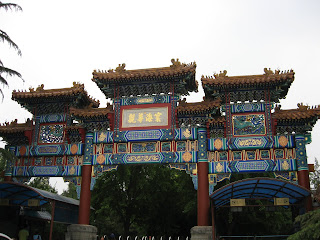 Beijing Bell Tower - Zhonglou
Beijing Bell Tower - ZhonglouThese buildings were once played significant roles for time announcements in the old Yuan, Ming and Qing Dynasty. Previously the daily activities for the people were very much dependent on the time announcement from the buildings (well, there were no watches or clocks like now). However with the demise on the Qing dynasty, their original functions were no longer exists and there are now meant for tourist visit.
Prince Gong's Mansion - Gong Wang Fu (恭王府)
This is the China’s largest and best-preserved princely residence with the total size for the compound area of more than 57,000 sq. It is an extravagant mansion built in siheyuan (四合院) layout and the Jiangnan (江南) garden style. It was constructed more than 200 years ago by was initially constructed for the corrupted minister He Shen (和珅), who was then the favorite minister for the Emperor QianLong. It was then given by Emperor XianFeng to his brother Prince Gong.
The ticket is priced at RMB40.00, slightly on the high side.
 The walkway for the building surrounding the courtyard
The walkway for the building surrounding the courtyard The interior view of one of the main hall – This is not opened to public
The interior view of one of the main hall – This is not opened to public One of the courtyard
One of the courtyard The pond surrounding
The pond surrounding Photo taken with the pond in the background
Photo taken with the pond in the background The main entrance
The main entrance The Yonghe Gate
The Yonghe Gate












No comments:
Post a Comment